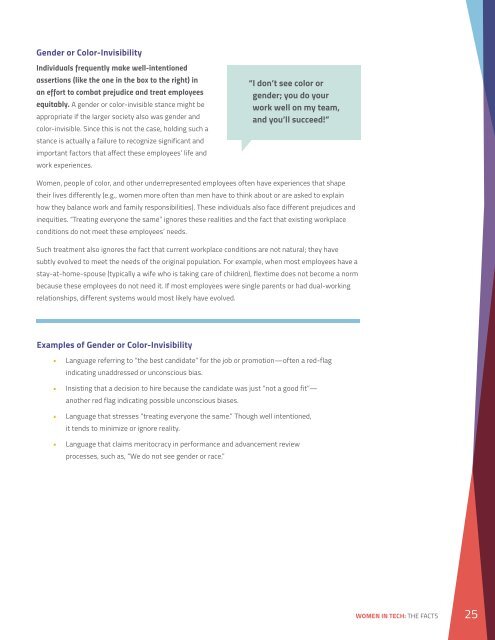WOMEN IN TECH THE FACTS
womenintech_facts_fullreport_05132016
womenintech_facts_fullreport_05132016
Create successful ePaper yourself
Turn your PDF publications into a flip-book with our unique Google optimized e-Paper software.
Gender or Color-Invisibility<br />
Individuals frequently make well-intentioned<br />
assertions (like the one in the box to the right) in<br />
an effort to combat prejudice and treat employees<br />
equitably. A gender or color-invisible stance might be<br />
appropriate if the larger society also was gender and<br />
color-invisible. Since this is not the case, holding such a<br />
stance is actually a failure to recognize significant and<br />
important factors that affect these employees’ life and<br />
work experiences.<br />
“I don’t see color or<br />
gender; you do your<br />
work well on my team,<br />
and you’ll succeed!”<br />
Women, people of color, and other underrepresented employees often have experiences that shape<br />
their lives differently (e.g., women more often than men have to think about or are asked to explain<br />
how they balance work and family responsibilities). These individuals also face different prejudices and<br />
inequities. “Treating everyone the same” ignores these realities and the fact that existing workplace<br />
conditions do not meet these employees’ needs.<br />
Such treatment also ignores the fact that current workplace conditions are not natural; they have<br />
subtly evolved to meet the needsof the original population. For example, when most employees have a<br />
stay-at-home-spouse (typically a wife who is taking care of children), flextime does not become a norm<br />
because these employees do not need it. If most employees were single parents or had dual-working<br />
relationships, different systems would most likely have evolved.<br />
Examples of Gender or Color-Invisibility<br />
• Language referring to “the best candidate” for the job or promotion—often a red-flag<br />
indicating unaddressed or unconscious bias.<br />
• Insisting that a decision to hire because the candidate was just “not a good fit”—<br />
another red flag indicating possible unconscious biases.<br />
• Language that stresses “treating everyone the same.” Though well intentioned,<br />
it tends to minimize or ignore reality.<br />
• Language that claims meritocracy in performance and advancement review<br />
processes, such as, “We do not see gender or race.”<br />
<strong>WOMEN</strong> <strong>IN</strong> <strong>TECH</strong>: <strong>THE</strong> <strong>FACTS</strong> 25


